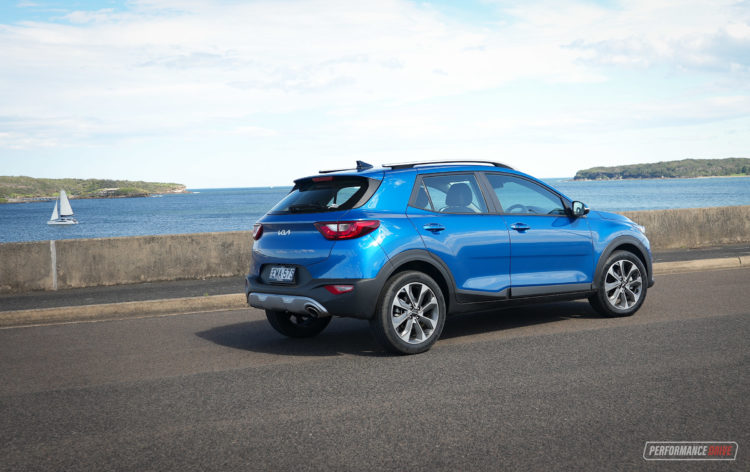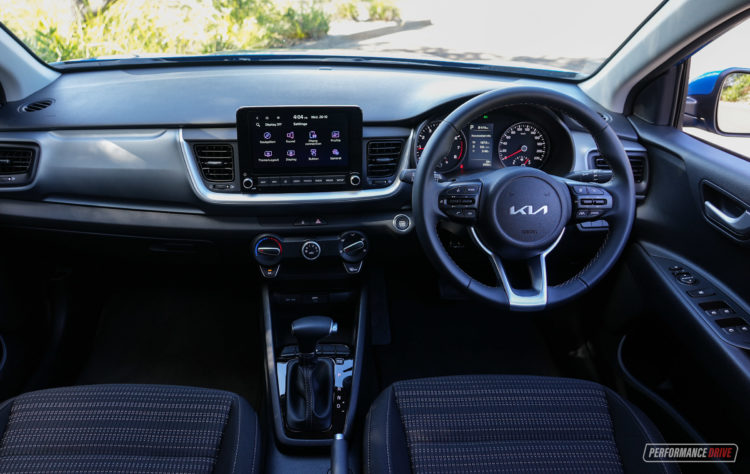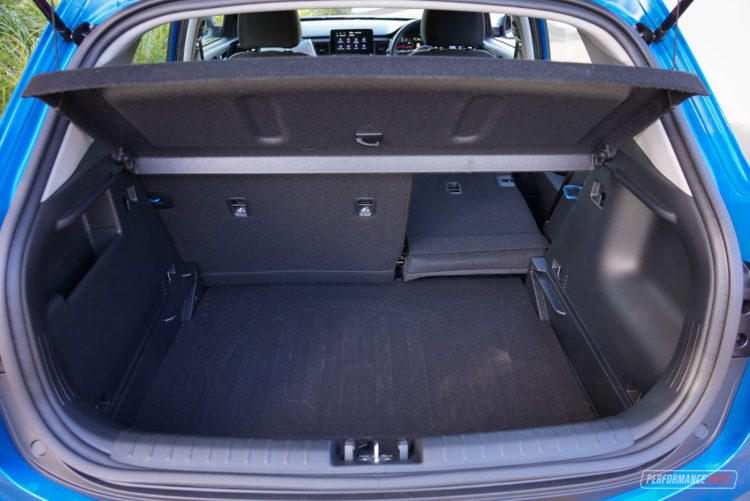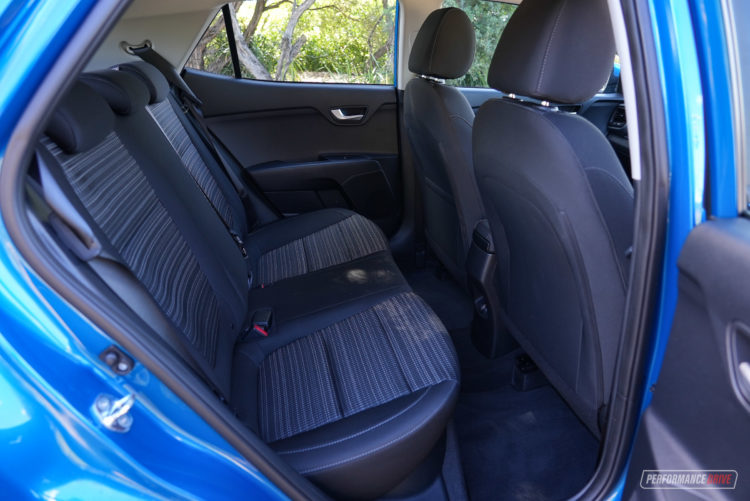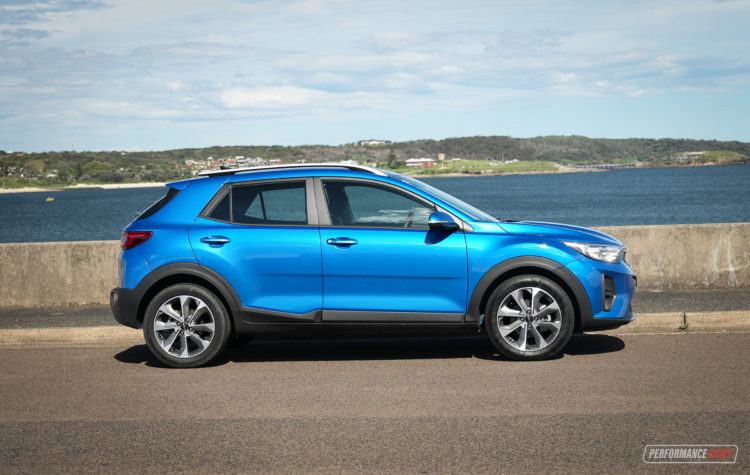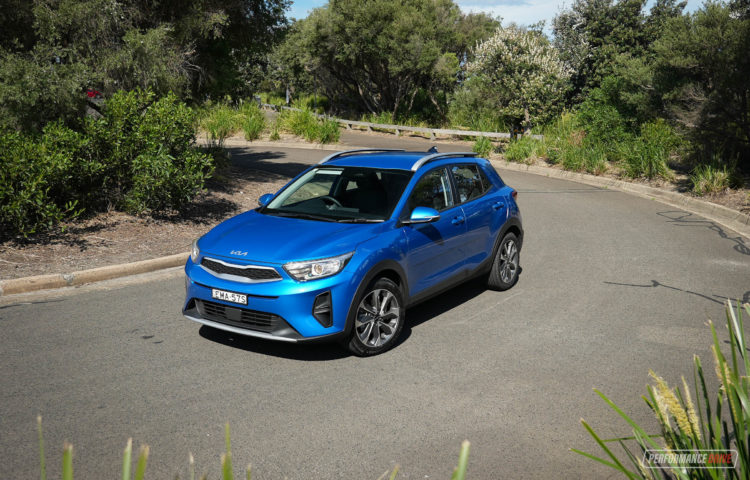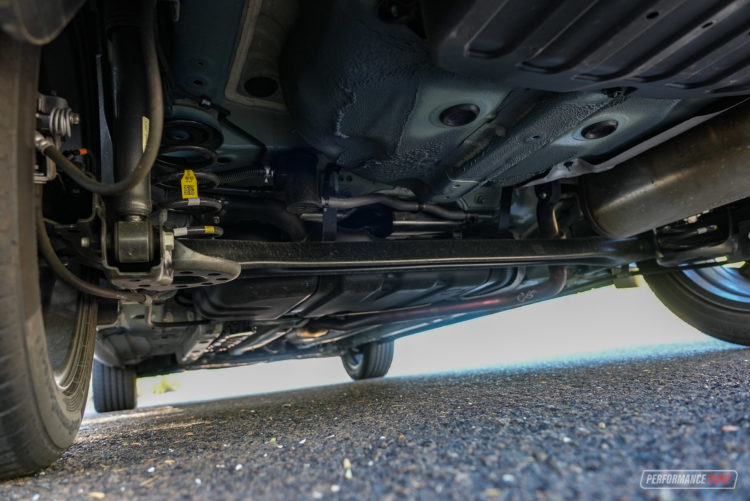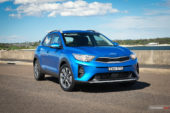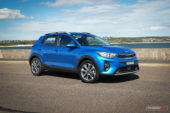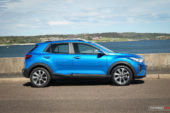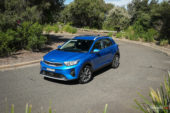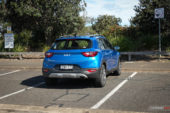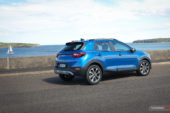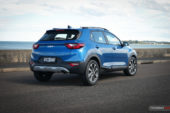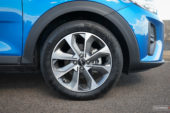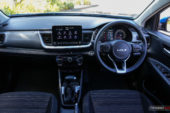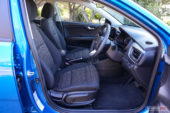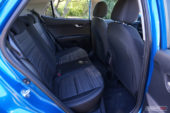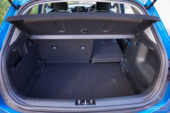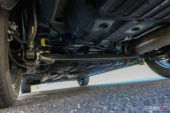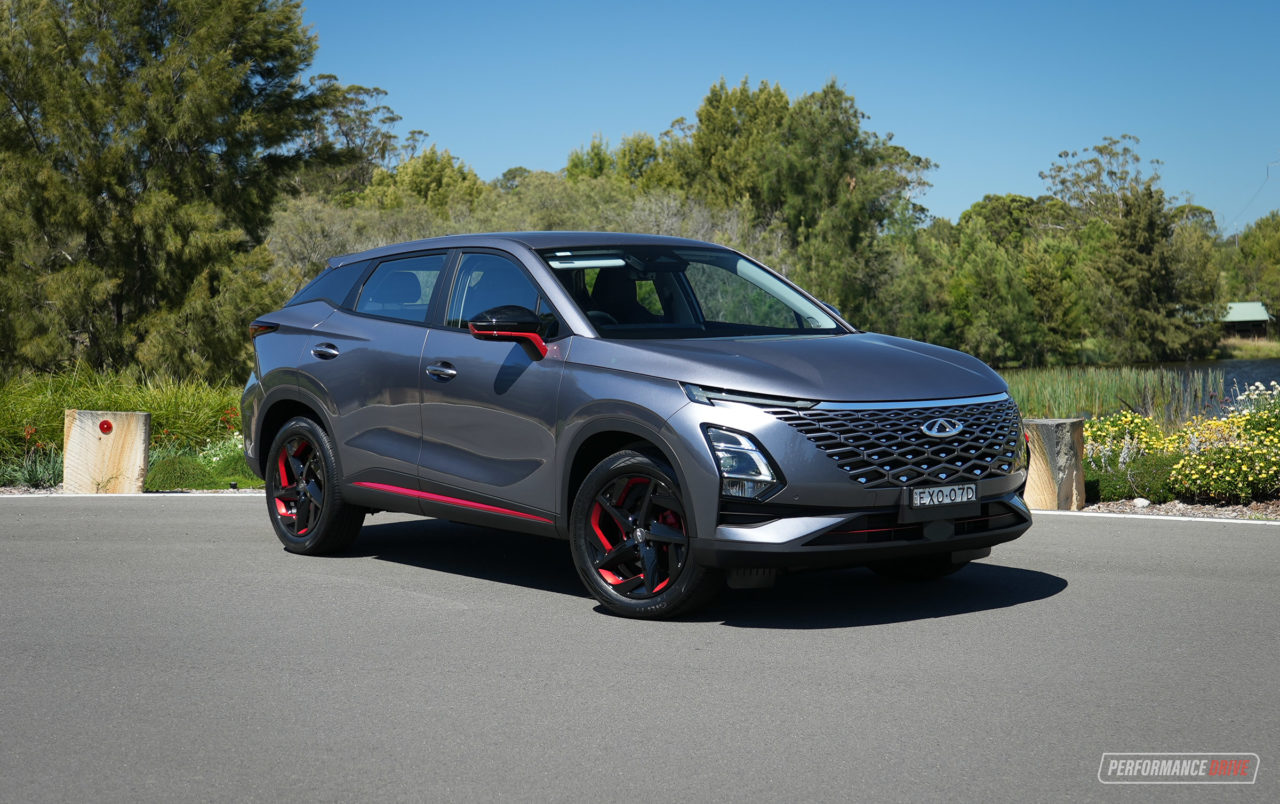With the popularity of SUVs today, Kia could never offer too many models. The baby in a fleet of four SUVs is the popular Kia Stonic. It is an easy one for Kia as it is based on the Kia Rio. Throughout 2022, the Korean brand sold 8557 units in Australia, which accounted for 16.2 per cent of the light SUV market – only second behind the Mazda CX-3.
Buyers can select from the entry level S, the midrange Sport, or the range topping GT-Line. The S and Sport come with a 1.4-litre non-turbo four-cylinder petrol engine with a choice of a six-speed manual or six-speed auto transmission. The top spec GT-Line comes uniquely with a 1.0-litre three-cylinder turbo-petrol engine and a seven-speed dual-clutch auto. All models are driven by front wheels only.
Here, we’re testing the mid spec Sport in auto guise, which retails from $27,790. Prices kick off at a thrifty $22,290 for the S manual, and peak at $30,790 for the GT-Line (excluding on-road costs).
2022-2023 Kia Stonic Sport – THE SPECS
[column width=”47%” padding=”6%”]Engine: 1.4-litre petrol four-cylinder
Output: 74kW@6000rpm / 133Nm@4000rpm
Transmission: Six-speed auto
Drive type: Front-wheel drive
Wheels: F &: 17×6.5, 205/55
ANCAP: Five stars
Tare weight: 1192kg
Power-to-weight: 16.10:1 (kg:kW)
Official fuel economy: 6.7L/100km
Economy during test: 7.1L/100km
Fuel capacity/Type: 45L/91 RON[/column] [column width=”47%” padding=”0″]Power efficiency: 11.04kW:L/100km
0-60km/h: 5.95 seconds*
0-100km/h: 13.26 seconds*
60-110km/h: 10.23 seconds*
1/4 mile: 19.24 seconds at 118.9km/h*
Max acceleration: 0.539g*
100-0km/h braking: 2.97 seconds at 38.55 metres*
Max deceleration: -1.189g*
Decibel at idle: 40*
Peak decibel at 60-100km/h: 77*
Priced from: $27,790[/column][end_columns]
* Figures as tested by PerformanceDrive on the day. Factory claims may be different
2022-2023 Kia Stonic Sport – THE PACKAGE
Even though the Kia Stonic is based on the same platform as the Kia Rio, external design differs. The Stonic blends into the crowd with its conservative and cute appearance. There is a small front grille and charming headlights all in the shape of a happy, approachable face.
Off-road strength can be perceived with brushed metal look front and rear lower bumpers and hard plastic lower fenders around the doors and wheel arches. Brushed metal roof rails also add to its sense of adventure. There is a slight increase of ground clearance over the Rio (43mm) but thanks to a fairly low roofline, the overall appearance of the Stonic resembles more of a hatch than a bulky SUV.
Turning to the inside and space in the front row is surprisingly roomy for the smallest SUV in the range. Use of space has vastly improved over the decades. The Stonic offers admirable legroom and headroom. There is still room for a decently sized shelf in front of the gear selector, cup holders in the centre, big bottle holders in the doors, a ceiling sunglasses holder, and a centre console with a lid (excluding in the base S). Centre consoles with lids are often excluded in this light size market.
At the rear, space is expectedly more of a squeeze. If tall passengers are in the front, there is not much legroom left over. At least there is enough foot space for your feet under the front seat. If you plan to use the back seat a lot, it would suit young kids or short trips as creature comforts like rear air vents and a pull-down centre armrest are omitted.
Further back, boot space available is slightly below average, at 332 litres. It is 68 litres bigger than the Mazda CX-3, but 58 litres smaller than the Toyota Yaris Cross, 53 litres smaller than the Volkswagen T-Cross, and 33 litres smaller than the Hyundai Venue. The boot lip is also quite high, comparatively. There is still plenty of room for the weekly grocery shop, and the large pocket on the left-hand side is handy to help with slim items you don’t want to slide around. If you need more space, the 60/40 split/fold rear seats can be folded down to create 1132 litres of space.
When testing so many different cars, it’s always nice to jump into a down-to-earth car like the Stonic, where you can instantly find your way around. Button layouts and gauges are as simple as they come; and materials used feel hard and strong. There is not much in the way of beaming elegance, but it’s practical and not distracting. Drivers get basic six-way seat adjustments, and front passengers get four-way adjustments, but they are still supportive and comfortable.
In terms of tech, all Stonics receive the same vivid 8.0-inch touch-screen with multi-phone Bluetooth connection, and wired Android Auto. Oddly, wireless Android Auto and wireless Apple CarPlay only come with the base S, yet it is the newest technology out. Then wired Apple CarPlay only comes with the Sport and GT-Line. Go figure. The Sport and GT-Line step it up with digital radio and sat-nav with 10-years of traffic info and map updates.
All Stonic models come with the important safety and convenience features, like forward collision warning with pedestrian avoidance, active lane-keeping assist and departure warning, driver attention detection with lead vehicle departure alert, a rear-view camera, rear parking sensors, auto headlights with auto dipping high-beam, and a 4.2-inch digital info screen in the instrument cluster.
If you opt for the Sport, the extra $3k gives you proximity sensor remote locking, 17-inch alloy wheels (instead of 15-inch steel wheels), push button start, illuminated vanity mirrors in the sun visors, and electric folding and heated side mirrors.
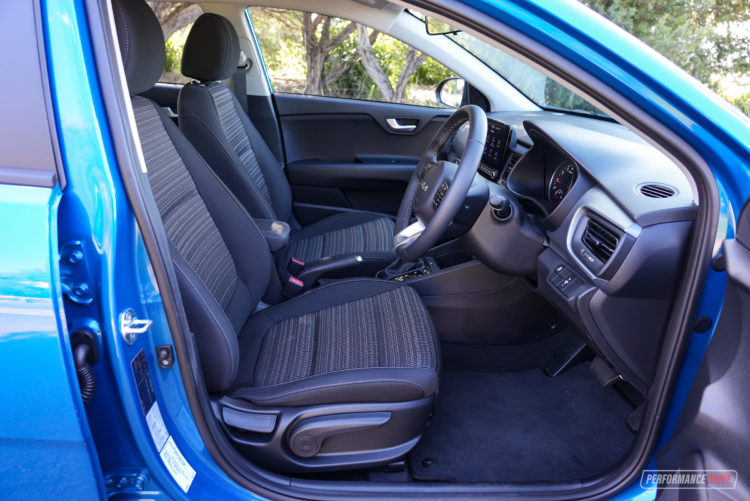
The Stonic stands up very well in terms of price compared with the competition. When you put all the cheapest variants side-by-side, the Stonic is between $500 and $8000 cheaper than the competition. That includes the Mazda CX-3, Nissan Juke, Ford Puma, Toyota Yaris Cross, and Volkswagen T-Cross. The only competitors that are cheaper are the Hyundai Venue, by $1000, and the Suzuki Ignis, by $1800. Though, some brands offer a more comprehensive choice of variants with more features as you move up the price line.
Kia offers the second-best warranty in the country, with seven years and unlimited kilometres. You also get one year of free roadside assistance. Servicing is required every 15,000km or 12 months (every 10,000km for the GT-Line 1.0-litre engine). Servicing costs for the 1.4-litre auto are:
1 Year or 15,000km $269
2 Years or 30,000km $455
3 Years or 45,000km $323
4 Years or 60,000km $608
5 Years or 75,000km $303
6 Years or 90,000km $586
7 Years or 105,000km $322
2022-2023 Kia Stonic Sport – THE DRIVE
We should preface this section stating that our expectations were already low given the Stonic is an everyday car on the most affordable end of the market. Even so, the 1.4-litre petrol engine here is awfully underpowered and difficult to live with in our opinion. Engines this tiny usually come with a turbo to give them a kick up the keister. This engine gets bogged down and struggles. 74kW and 133Nm is trifling, but it feels even less than those figures suggest.
The 0-100km/h sprint is achieved in 13.26 seconds, according to our Vbox testing. Going up hills is a thrashy affair, and taking over other cars reveals a painstakingly breathless task. The 1.0-litre turbo in the GT-Line also has 74kW, but uses a turbo. It boosts torque by about a quarter, to 172Nm.
To make matters worse, the six-speed auto locks itself in a high gear unless you really plant your foot. At this point, it aimlessly hunts around for the best gear ratio to maximise acceleration, but gets lost in the process. It reminds us of the old four-speed auto days in small cars, where you hit a brick wall if you’re already rolling and need to accelerate. It almost feels like coming to a stop and taking off will be faster.
With respect to driving dynamics, the Stonic feels sturdy and nimble on the road. Even though it is fitted with a cheaper coupled torsion beam axle at the rear instead of independent suspension, the car itself is small and light enough to not tell. When tackling corners, only minor body roll comes through.
Also, the usual local tuning done here in Australia by Kia also applies to the Stonic. This results in a ride that better suits Australian tastes – not too soft, but still able to brilliantly absorb shocks from our rough roads. It glides over bumps rather undisturbed. The handy increased ground clearance you get from SUVs also gives greater suspension travel to spring those bumps.
The steering offers an ideal amount of weight at low speeds for easy manoeuvring, and a heavier feel at highway speeds to make it secure to balance in the lane.
Officially, the Stonic Sport burns fuel at an average of 6.7L/100km. Our average was higher with 7.4L/100km as we hunted for more power. With little oomph, you’re inclined to put your foot down more. For a small capacity engine like this one, there is room for improvement. On the plus side, it is compatible with the cheapest fuel on the market; E10 and 91RON fuel.
2022-2023 Kia Stonic Sport – THE VIDEO
2022-2023 Kia Stonic Sport – THE VERDICT
Getting the bad over with first, we have nothing nice to say about the drivetrain. The sluggishness is unliveable, and so it vastly affects the whole Stonic package for us. If you can move past it, there are some positives. Its cheap, easy to drive, has all the important safety features you need, and comes with an excellent warranty. All reasons why it sells so well.
The entire range falls among the cheaper end of the light SUV market as there are no all-wheel drive variants, nor luxury variants. That is where you would start slipping into bigger sibling Seltos territory.
[column width=”47%” padding=”6%”]PROS:
– One of the most affordable in the light SUV segment
– Conservative and friendly exterior design
– Simple-to-navigate interior
– Good safety features list[/column] [column width=”47%” padding=”0″]CONS:
– Handicapped for power
– Fuel consumption should be better for such a small, light car
– Tilt-only adjustable steering wheel – no telescopic adjustment[/column][end_columns]
As always, if you’re thinking about buying a new car don’t forget to click here to speak with our car buying specialists.

